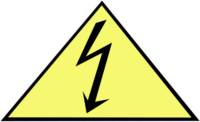 On August 6, 2003, a 44-year-old male farmer was welding a feed bunker wagon when he was electrocuted.
On August 6, 2003, a 44-year-old male farmer was welding a feed bunker wagon when he was electrocuted.
The portable 240-volt plug-in cord-connected Hobart welder was in disrepair. The power cord and the cables had damaged insulation exposing the conductors. The welder lead cables were at least 10 years old and were 12 feet long.
The victim parked the feed bunker wagon near a wooden building that was filled with tools and junk metal. The victim had attached the ground cable to the feed bunker wagon. The welder was plugged into an outlet that had exposed conductors and, according to the police report, also had other items plugged into it.
To allow the welding leads to reach the location of the feed bunker wagon, the victim connected two sets of welding cables and placed the un-insulated cable splices on bare dirt.
The victim was lying on damp, bare ground and was sweating heavily, as indicated by his perspiration-soaked short sleeve shirt.
An individual who had been previously working with the victim found the victim under the feed bunker wagon with the welder cables lying across his lap. The victim was wearing his welding helmet. He was not wearing gloves. The victim was sitting up under the trailer with his head resting on a metal support railing under the feed bunker wagon.
According to the police report, the person who found the victim knelt down and put his hands on the soil and received a “large” shock. This individual turned off the welder and called for assistance. The victim was declared dead at the scene.
Recommendations:
- Maintain equipment in proper operating condition.
- Use appropriate personal protective equipment and ensure that it is in proper working order.
- Develop safe work procedures for welding operations, especially for splicing welding leads.
- Identify other potential safety issues, such as the need for a ground fault circuit interrupter (GFCI).
Source: NIOSH



